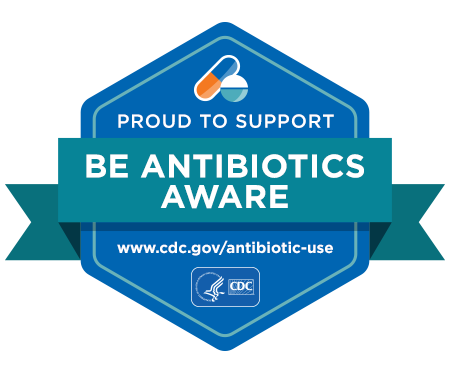
Antibiotic Stewardship
Central to a comprehensive program to combat antibiotic-resistant bacteria is antibiotic stewardship (also referred to as antimicrobial stewardship) within healthcare systems and throughout the healthcare community. Antibiotic stewardship is a program by which facilities are able to monitor, reduce and prevent misuse and/or overuse of antibiotics within a healthcare system using a multidisciplinary team and strategic approach.
The Qsource provides outreach, education and technical assistance to implement the CDC’s Core Elements of antibiotic stewardship in outpatient settings. Our team is working to establish and implement antimicrobial stewardship program activities in outpatient settings that are effective, sustainable and can be tailored to the clinical needs of those settings.
Outpatient settings who may participate include:
- Federally-Qualified Health Centers (FQHCs)
- Emergency Departments
- Outpatient Clinics
- Outpatient pharmacies
- Pharmacy-based clinics
- Physician Offices
- Public Health Clinics
- Urgent Care

State Contacts:
Alabama
Teresa Fox
(256) 293-9994
[email protected]
Indiana
Cathie Moore
(765) 505-3529
[email protected]
Kentucky
Susan Anderson-Lenz, M.S. HIM
(859) 300-2118
[email protected]
Mississippi
Kim Roberts
(601) 957-1575, ext. 245
[email protected]
Tennessee
Eric Sullivan
(615) 390-3672
[email protected]
Drug interactions between Warfarin and antibiotics
CDC: Antimicrobial ResistanceCDDEP: Antibiotic Resistance
CIDRAP: Antimicrobial Stewardship
CDC: Antibiotic Stewardship
FDA: Antimicrobial Resistance
USDA: Antimicrobial Resistance
CDC Core Elements of Outpatient Antibiotic Stewardship (website)
Core Elements of Outpatient Antibiotic Stewardship (document)
Recommendations for appropriate outpatient antibiotic prescribing
IDSA Clinical Practice Guidelines
Medicare Part D Prescriber Data – antibiotics, opioids, and other high-risk medications
Checklist for Antibiotic Prescribing in Dentistry
Deadly diarrhea: C. diff infographic
National Security Threats Posed by “Superbugs”
C. diff Foundation
Retail Pharmacy’s Role in Antimicrobial Stewardship
Antimicrobial Stewardship: How the Community Pharmacist Can Help
Hand Hygiene in Healthcare Settings
My 5 Moments for Hand Hygiene
Partnering to Heal
National Healthcare Safety Network (NHSN)
Association for Professionals in Infection Control and Epidemiology (APIC)
Clostridium difficile Infection (CDC)
Download this video (with sound)
Download this video (with no sound)
CDC Commentary: Antibiotic Stewardship in the Outpatient Setting – Nov 2016 – (6 minutes)
CDC Commentary: Don’t Give In and Give Those Antibiotics! – Nov 2010 – (4 minutes)
Fight C. diff – Public Service Announcement
Fight C. diff – Educational Video
C. diff Stories
How antibiotic stewardship can help prevent C. difficile infections
CDC Vital Signs: Stop the Spread of Antibiotic Resistance
Ventilator Associated Events Webinar Transcript
NCC VAE Webinar
Webinar delivered June 10, 2015 by the National Coordinating Center (NCC)
AHRQ Patient Safety Videos – Featuring CUSP and TeamSTEPPS
Select Nashville Antibiotics Stewardship
Select Nashville Antibiotics Stewardship (Unedited)
Watch this brief video to see how one Nashville facility built a successful Antibiotic Stewardship Program.
Antibiotic Stewardship National LAN Event
Presentation Slides: http://qioprogram.org/sites/default/files/editors/141/Antibiotic_Stewardship_National_LAN_Event_Slides_20170830_Post_508.pdf
Recorded Presentation: https://www.youtube.com/watch?v=3yI9wLgwMKM&feature=youtu.be
Audience: This event was open to beneficiaries, families, healthcare providers, practitioners, partners, and Quality Innovation Network-Quality Improvement Organizations.
Event Description: This event focused on successful physician-to-patient communication strategies to avoid unnecessary antibiotic prescribing. During this webinar participants learned cutting edge techniques from guest speaker Dr. Rita Mangione-Smith on how to manage expectations for antibiotics in order to avoid unnecessary prescribing while maintaining satisfaction with care.
Learning Objectives:
- Explain why providers prescribe antibiotics inappropriately.
- Discuss why communications training is a good option to improve outpatient antibiotic prescribing.
- Learn how patients most commonly communicate their expectations for antibiotics during visits for acute respiratory infection, and how this can lead to unnecessary antibiotic prescribing.
- Gain an understanding of how to best manage expectations for antibiotics in order to avoid unnecessary prescribing while maintaining satisfaction with care.
The Antibiotic Stewardship National LAN Event – slides & recording available: http://qioprogram.org/antibiotic-stewardship-national-lan-event-august-2017
Overview of the Patient Safety Component
Course Description
- Introduction to NHSN training and Changing Purposes [Video – 42 min] March 2014
- Introduction to NHSN training and Changing Purposes [PDF – 3.2 MB] March 2014
- Keeping the Public’s Trust [Video – 33 Min] March 2014
- Keeping the Public’s Trust [PDF – 4.91 MB] March 2014
- Overview of the Patient Safety Component [PDF – 464 KB]
Data Entry and Analysis
Obtaining Continuing Education for NHSN Training
Device-associated Module
Introduction to Device-associated Module
Central Line-associated Bloodstream Infection (CLABSI)
- Central Line-associated Bloodstream Infections (CLABSI) Part I [Video – 78 min] March 2014
- CLABSI Part II-Secondary BSI and NHSN Site-Specific Infection Definitions with Case Studies [Video – 78 min] March 2014
- Central Line-associated Bloodstream Infections (CLABSI) [PDF – 3 MB] March 2014
Catheter-associated Urinary Tract Infection (CAUTI)
- Course description
- Catheter-associated Urinary Tract Infection (CAUTI) with Case Studies (Part I) [Video – 87 min] March 2014
- Catheter-associated Urinary Tract Infection (CAUTI) with Case Studies (Part II) [Video – 46 min] March 2014
- Catheter-associated Urinary Tract Infection (CAUTI) with Case Studies [PDF – 16 MB] March 2014
Central Line Insertion Practices (CLIP)
Ventilator-Associated Events (VAE)
- Ventilator-Associated Events Training [Video – 102 min] March 2014
- VAE Training [PDF – 13 MB] March 2014
- Ventilator-associated Case Studies Training [Video – 33 min] March 2014
- Ventilator-associated Case Studies Training [PDF – 18 MB] March 2014
Ventilator-associated Pneumonia (VAP)
- Course description
- Introduction to Patient Safety Component
- Device-associated Module
- Procedure-associated Module
- MDRO and CDI Module
- Vaccination Module
Procedure-associated Module
Introduction to Procedure-associated Module
Surgical Site Infection (SSI)
- Course description
- Surgical Site Infections (SSI) Surveillance with Case Studies (Part I) [Video – 90 min] March 2014
- Surgical Site Infections (SSI) Surveillance with Case Studies (Part II) [Video – 122 min] March 2014
- Surgical Site Infections (SSI) Surveillance with Case Studies [PDF – 6 MB] March 2014
Multidrug-resistant Organism and Clostridium difficile Infection (MDRO/CDI) Module
MDRO, C.difficile Infection Surveillance and LabID Event Reporting
- MRSA Bacteremia and CDI LabID Event Reporting with Case Studies (Part I) [Video – 82 min] March 2014
- MRSA Bacteremia and CDI LabID Event Reporting with Case Studies (Part II) [Video – 45 min] March 2014
- MRSA Bacteremia and CDI LabID Event Reporting with Case Studies [PDF – 6.41 MB] March 2014
Prevention Process and Active Surveillance Testing Outcome Measures
- Prevention Process and Active Surveillance Testing Outcome Measures Video [WMV – 3.57MB]
- Prevention Process and Active Surveillance Testing Outcome Measures [PDF Slide set – 1.24MB] Dec 2008
Vaccination Module
- Vaccination Module Training [PDF Slide set – 975 KB]
C.Diff Harms Residents Infographic
Qsource Pinterest Board: Infection Prevention
The QIO Program helps you embrace data in your healthcare setting
Failure Modes & Effects Analysis (FMEA)
The QIO Program shares 5 steps in the Failure Modes and Effects Analysis (FMEA) to anticipate potential problems before they occur
Root Cause Analysis (RCA)
The QIO Program demonstrates how to identify the root cause of a problem using The 5 Whys
QIO Documentary
Learn about the history of the QIO Program, from 1966 through today.
IHI Whiteboard: Model for Improvement, Clip 1
IHI Whiteboard: Model for Improvement, Clip 2
IHI Whiteboard: PDSA Cycles, Part 1
IHI Whiteboard: PDSA Cycles, Part 2
IHI Whiteboard: Cause & Effect Diagrams
 Skip to main content
Skip to main content





